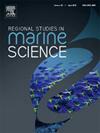越南东海潮汐能潜力估算:利用半经验潮汐模型进行综合分析
IF 2.1
4区 环境科学与生态学
Q3 ECOLOGY
引用次数: 0
摘要
本研究对越南东海(VES)的潮汐能潜力进行了评估,该地区水动力复杂,与西太平洋相互作用密切。根据越南东海地区 34 个验潮站组成的广泛网络,对六个著名的半经验全球海洋潮汐模型(FES2014、DTU16、EOT20、GOT4.10c、HAMTIDE12、OSU12.V1)进行了严格验证。验证结果表明,FES2014 是更优越的模型,由于其先进的数据同化技术、高分辨率网格以及受 VES 复杂水深影响的强大流体动力表现,该模型与观测结果的吻合度最高。利用 FES2014 模型,半昼夜分量(M2)在决定能量分布方面的影响作用非常明显。潮汐振幅的评估结果显示了三个新出现的热点地区:Batang Lupar 河口(马来西亚)、安埔岗(中国)和Bac Lieu(越南),潮汐振幅高达 326.2 厘米。安埔港的理论潜在潮汐能量最高,达到 14.90 Wh/m2,是最有希望进行本地化潮汐发电开发的地点。虽然与全球知名的地点相比,这些已确定的 VES 热点并不突出,但仍值得考虑根据当地条件开展中小型项目。虽然这项研究仅限于潜在的能源评估,但它为 VES 地区提供了一个重要的基线,凸显了可持续潮汐能开发的机遇。本文章由计算机程序翻译,如有差异,请以英文原文为准。
Estimation of tidal energy potential in the Vietnam East Sea: A comprehensive analysis using semi-empirical tide models
This study assesses the tidal energy potential in the Vietnam East Sea (VES), a region with complex hydrodynamics and significant interactions with the Western Pacific Ocean. A rigorous validation of six prominent semi-empirical global ocean tide models (FES2014, DTU16, EOT20, GOT4.10c, HAMTIDE12, OSU12.V1) was conducted against an extensive network of 34 tide gauge stations in the VES region. The validation identified FES2014 as the superior model, exhibiting the closest agreement with observations due to its advanced data assimilation techniques, high-resolution grids, and robust hydrodynamic representation influenced by the complex VES bathymetry. Leveraging the FES2014 model, the influential role of the semi-diurnal component (M2) in dictating energy distribution is prominently evident. Evaluation results of tidal amplitudes revealed three emerging hotspots: the Batang Lupar estuary (Malaysia), Anpu Gang (China), and Bac Lieu (Vietnam), with tidal amplitudes up to 326.2 cm. The Anpu Gang exhibited the highest theoretical potential tidal energy of 14.90 Wh/m2, making it the most promising site for localized tidal power development. Although moderate compared to globally renowned sites, the identified VES hotspots merit consideration for small-to-medium scale projects tailored to local conditions. While limited to potential energy assessments, this study provides a crucial baseline for the VES region, highlighting opportunities for sustainable tidal energy exploitation.
求助全文
通过发布文献求助,成功后即可免费获取论文全文。
去求助
来源期刊

Regional Studies in Marine Science
Agricultural and Biological Sciences-Ecology, Evolution, Behavior and Systematics
CiteScore
3.90
自引率
4.80%
发文量
336
审稿时长
69 days
期刊介绍:
REGIONAL STUDIES IN MARINE SCIENCE will publish scientifically sound papers on regional aspects of maritime and marine resources in estuaries, coastal zones, continental shelf, the seas and oceans.
 求助内容:
求助内容: 应助结果提醒方式:
应助结果提醒方式:


